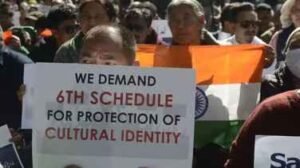Sonam Wangchuk, an active campaigner for constitutional safeguards for Ladakh, said on Tuesday that the scheduled “fast unto death” protest would be reviewed next week based on the success of negotiations with the Centre over their several demands, including statehood for the Union Territory.
“We will call a huge public gathering in Leh city on February 26 to either thank the government for accepting the demands of the people of Ladakh or go on a fast unto death if the talks fail,” said Wangchuk, who planned to launch a hunger strike until death on Tuesday in support of the demands.
The Ladakh leadership, now camped in the national capital, temporarily suspended the “fast unto death” initiative following a new round of discussions with the central government on Monday, describing the development as important. It stated that the Centre has agreed to address in detail the demands for Ladakh’s statehood, the inclusion of the Union Territory in the Sixth Schedule of the Constitution, and the establishment of a dedicated public service commission for the high-altitude area.
The agreement was reached during a meeting between the High Powered Committee (HPC) for Ladakh, led by Union Minister of State for Home Nityanand Rai, and a 14-member delegation from the Apex Body of Leh (ABL) and the Kargil Democratic Alliance (KDA), which represented various Union Territory organizations.
WHY HAVE PROTESTS ERUPTED IN LADAKH?
Four demands are central to the protests in Ladakh: statehood, tribal status, job reservations for locals, and a parliamentary seat for each of the Leh and Kargil districts.
LADAKH STATEHOOD DEMAND
People are concerned that now that Ladakh is directly controlled by the Indian government, it will lose past guarantees in terms of land and jobs, culminating in a shift in its tribal population. Residents believe that without a legislature, the Centre would authorize developmental and industrial projects in environmentally sensitive Ladakh without their approval.
Under Article 3, Parliament has the authority to establish a new state. In Indian history, Union Territories have already been given statehood. Goa, India’s smallest state spanning 3,702 square kilometers, was awarded statehood in 1987. Ladakh, which is larger than Kashmir, is 59,146 square km.
TRIBAL STATUS UNDER SIXTH SCHEDULE
Ladakh, which has a tribal population of more than 97%, has requested protection under the Constitution’s sixth schedule. Political parties in the UT have referenced precedents set by states such as Mizoram, Sikkim, and other northeastern states while pursuing tribal status.
Locals are concerned that with Article 370 repealed, foreigners may acquire property and compete for employment formerly designated for Ladakh locals. In 2019, the National Commission for Scheduled Tribes supported Ladakh’s inclusion in the sixth schedule due to its predominantly tribal population. So yet, no regions other than the Northeast have been featured in the sixth schedule.
EMPOWERMENT OF HILL COUNCILS
Another point of controversy has been the BJP’s commitment to strengthen the Ladakh Autonomous Hill Development Councils in Leh and Kargil. The demonstrators claim that it has been put on hold despite the BJP’s promise of increased financial and administrative powers for councils.
In actuality, councils’ powers, which were more autonomous before 2019, have been confined to the collection of municipal levies such as parking fines. The demonstrators also sought a Public Service Commission, citing a lack of advertised employment positions in the region.
What does the Government ensure?
In December, the BJP-led Centre assured a delegation from Ladakh that it was dedicated to accelerating the development of the Union Territory and achieving the region’s people’s expectations. The guarantee was conveyed during a meeting with the Ladakh High Power Committee.
The Union Ministry of Home Affairs (MHA) established the HPC for Ladakh, chaired by Rai, to debate the steps required to conserve the region’s distinctive culture and language, taking into account its geographical position and strategic importance.
The HPC has also been formed to protect land and employment, to promote inclusive development and job creation in the region, to empower the Ladakh Autonomous Hill Development Councils (LAHDCs) of Leh and Kargil, and to provide constitutional safeguards to ensure the aforementioned measures and protections.
Several groups in Ladakh have wanted a distinct Union Territory for the area for decades, and their desire was met on August 5, 2019. However, the KDA and ABL have recently protested in many areas, including New Delhi, Jammu, and Ladakh, to emphasize their primary demands.










